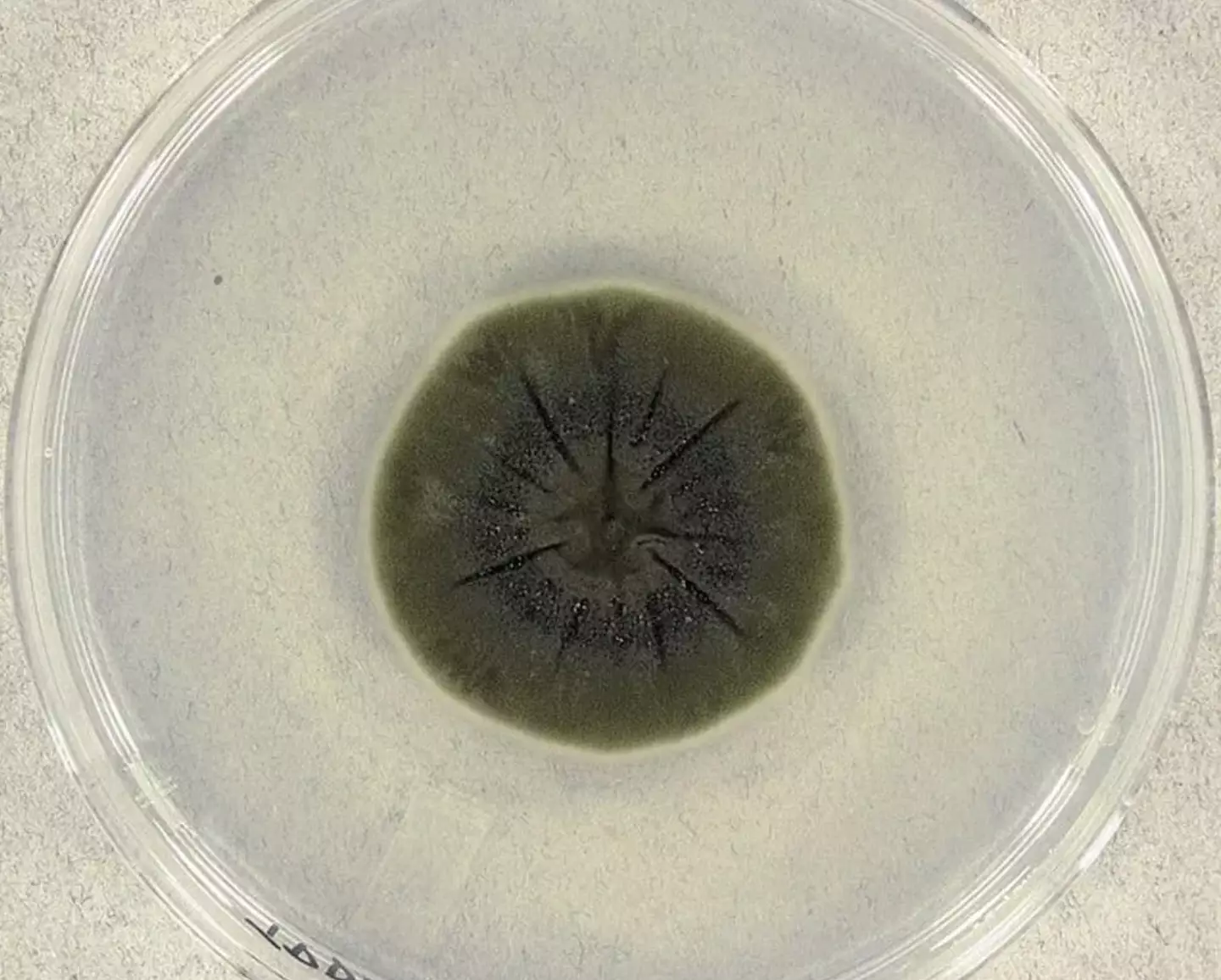When reactor number four in Chernobyl exploded, it triggered the worst nuclear disaster in history, one which the surrounding area still has not yet recovered from.
After the disaster at the Ukrainian nuclear power plant, scientists working in the ruined remains of reactor four discovered a strange black mould that was growing over the building walls despite the dangerous levels of radiation around it.
Indeed, the radiation actually didn’t seem to be doing much damage to this fungus and it appeared to be growing in environments where no human would be expected to survive.
Indeed, the Royal Society of Biology reckons this friendly fungus is ‘eating gamma radiation for breakfast’, which is a pretty darn cool thing for it to do, after scientists realised that the fungus appeared to be actively seeking out areas with higher radiation.
What is the black fungus discovered in Chernobyl reactor 4?

Reactor number four at Chernobyl is contained, but the area has been profoundly affected
(Brendan Hoffman/Getty Images)
Its official fancy name is ‘Cladosporium sphaerospermum’, which is a more scientific way of referring to the fungus than calling it the black stuff growing on the walls in Chernobyl.
The fungus had been seen and examined a whole century before Chernobyl, but it’s something plenty of people would have stayed away from – although it could actually be pretty useful.
Whatever it might be used for, it’s undeniable that after the Chernobyl disaster this fungus found itself in an environment where it could not just survive but also thrive.
Why does the black fungus consume gamma radiation?

Before Russia’s invasion people could take tours of Chernobyl (SERGEI SUPINSKY/AFP via Getty Images)
Here’s the science-y bit, this black fungus in Chernobyl is part of a family of ‘radiotrophic fungi’ which can feed of ionising radiation, which is quite neat.
A study into the matter found that these fungi could basically eat radiation and use it to keep doing what they’re doing.
It’s somewhat like photosynthesis where plants take in sunlight to fuel their metabolic process, only this time the sunlight is ionising radiation.
It’s known as radiosynthesis, and there’s plenty of radiation to gobble up in Chernobyl.
As for why this all works it seems to be thanks to melanin, that pigment which gives us our skin and eye colours.
The Cladosporium sphaerospermum has a dark shell made of layers of melanin and this takes the energy from the radiation and uses it to grow the fungus.
What does the discovery mean and why it could be a good thing?

It may look sinister but it could actually be a huge help (Medmyco/Wikimedia)
While the idea of a strange black fungus that consumes radiation sounds like the starting point of a particularly sinister film where we get attacked by whatever mutated monster comes out of the fungus, this thing actually seems to be quite a help.
If this fungus can eat radiation then it could be a handy tool in areas affected by the ionising poison, though we shouldn’t expect it to gobble up a nuclear disaster’s worth of radiation.
According to Forbes, some of the fungus has been sent into space for tests aboard the International Space Station in an attempt to work out whether it could help protect astronauts from cosmic radiation.
Even if it can’t undo the damage at Chernobyl, there could be some great uses for it.
News
New mRNA therapy targets drug-resistant pneumonia
Bacteria that multiply on surfaces are a major headache in health care when they gain a foothold on, for example, implants or in catheters. Researchers at Chalmers University of Technology in Sweden have found [...]
Current Heart Health Guidelines Are Failing To Catch a Deadly Genetic Killer
New research reveals that standard screening misses most people with a common inherited cholesterol disorder. A Mayo Clinic study reports that current genetic screening guidelines overlook most people who have familial hypercholesterolemia, an inherited disorder that [...]
Scientists Identify the Evolutionary “Purpose” of Consciousness
Summary: Researchers at Ruhr University Bochum explore why consciousness evolved and why different species developed it in distinct ways. By comparing humans with birds, they show that complex awareness may arise through different neural architectures yet [...]
Novel mRNA therapy curbs antibiotic-resistant infections in preclinical lung models
Researchers at the Icahn School of Medicine at Mount Sinai and collaborators have reported early success with a novel mRNA-based therapy designed to combat antibiotic-resistant bacteria. The findings, published in Nature Biotechnology, show that in [...]
New skin-permeable polymer delivers insulin without needles
A breakthrough zwitterionic polymer slips through the skin’s toughest barriers, carrying insulin deep into tissue and normalizing blood sugar, offering patients a painless alternative to daily injections. A recent study published in the journal Nature examines [...]
Multifunctional Nanogels: A Breakthrough in Antibacterial Strategies
Antibiotic resistance is a growing concern - from human health to crop survival. A new study successfully uses nanogels to target and almost entirely inhibit the bacteria P. Aeruginosa. Recently published in Angewandte Chemie, the study [...]
Nanoflowers rejuvenate old and damaged human cells by replacing their mitochondria
Biomedical researchers at Texas A&M University may have discovered a way to stop or even reverse the decline of cellular energy production—a finding that could have revolutionary effects across medicine. Dr. Akhilesh K. Gaharwar [...]
The Stunning New Push to Protect the Invisible 99% of Life
Scientists worldwide have joined forces to build the first-ever roadmap for conserving Earth’s vast invisible majority—microbes. Their new IUCN Specialist Group reframes conservation by elevating microbial life to the same urgency as plants and [...]
Scientists Find a Way to Help the Brain Clear Alzheimer’s Plaques Naturally
Scientists have discovered that the brain may have a built-in way to fight Alzheimer’s. By activating a protein called Sox9, researchers were able to switch on star-shaped brain cells known as astrocytes and turn them into [...]
Vision can be rebooted in adults with amblyopia, study suggests
Temporarily anesthetizing the retina briefly reverts the activity of the visual system to that observed in early development and enables growth of responses to the amblyopic eye, new research shows. In the common vision [...]
Ultrasound-activated Nanoparticles Kill Liver Cancer and Activate Immune System
A new ultrasound-guided nanotherapy wipes out liver tumors while training the immune system to keep them from coming back. The study, published in Nano Today, introduces a biodegradable nanoparticle system that combines sonodynamic therapy and cell [...]
Magnetic nanoparticles that successfully navigate complex blood vessels may be ready for clinical trials
Every year, 12 million people worldwide suffer a stroke; many die or are permanently impaired. Currently, drugs are administered to dissolve the thrombus that blocks the blood vessel. These drugs spread throughout the entire [...]
Reviving Exhausted T Cells Sparks Powerful Cancer Tumor Elimination
Scientists have discovered how tumors secretly drain the energy from T cells—the immune system’s main cancer fighters—and how blocking that process can bring them back to life. The team found that cancer cells use [...]
Very low LDL-cholesterol correlates to fewer heart problems after stroke
Brigham and Women's Hospital's TIMI Study Group reports that in patients with prior ischemic stroke, very low achieved LDL-cholesterol correlated with fewer major adverse cardiovascular events and fewer recurrent strokes, without an apparent increase [...]
“Great Unified Microscope” Reveals Hidden Micro and Nano Worlds Inside Living Cells
University of Tokyo researchers have created a powerful new microscope that captures both forward- and back-scattered light at once, letting scientists see everything from large cell structures to tiny nanoscale particles in a single shot. Researchers [...]
Breakthrough Alzheimer’s Drug Has a Hidden Problem
Researchers in Japan found that although the Alzheimer’s drug lecanemab successfully removes amyloid plaques from the brain, it does not restore the brain’s waste-clearing system within the first few months of treatment. The study suggests that [...]





















